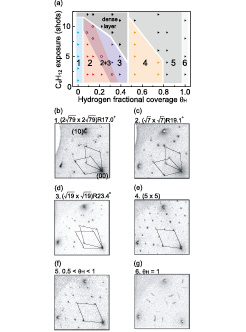Two-dimensional Superstructures of Cyclohexane on Rh(111) : Effects of Preadsorbed Hydrogen
Yoshinobu Group
Adsorption of alkane molecules on metal surfaces is an important subject in various fields. In particular, activation of C-H bonds of adsorbed alkanes through interaction with metal surfaces is a key process of dehydrogenation on heterogeneous catalysts. In order to understand the reaction mechanism, it is essential to elucidate the adsorption states and the nature of the adsorbate-metal interaction. Most of the previous studies deal with the adsorption of alkanes on clean metal surfaces. There are few studies concerning adsorption on hydrogen-preadsorbed metal surfaces, although it is a more relevant system for elucidating the reaction mechanism of the hydrocarbon conversion reaction which is usually performed in excess hydrogen.

Fig. 1 (a) A phase diagram of superstructures observed by SPA-LEED as a function of cyclohexane exposure and coadsorbed hydrogen coverage. All measurements were carried out at 90 K, and data points are indicated by dots. (b) – (g) SPA-LEED patterns of overlayer structures 1 to 6 in (a), together with the notations of the commensurate and HOC structures. The incident electron energy is 75 eV. Reciprocal unit cells of cyclohexane domains are indicated by lines.
In this study, we investigated adsorption structures and interaction of cyclohexane molecules on the clean and hydrogen-preadsorbed Rh(111) surfaces using scanning tunneling microscopy (STM), spot-profile-analysis low-energy electron diffraction (SPA-LEED), temperature-programmed desorption (TPD), and infrared reflection absorption spectroscopy (IRAS) [1]. Various ordered structures of adsorbed cyclohexane were observed as a function of hydrogen and cyclohexane coverages. When the fractional coverage (θH) of preadsorbed hydrogen was below 0.8, four different commensurate or higher-order commensurate superstructures were found as a function of θH; whereas more densely packed incommensurate overlayers became dominant at higher θH (Fig. 1). IRAS measurements showed sharp softened C-H vibrational peaks at 20 K, which originated from the electronic interaction between adsorbed cyclohexane and the Rh surface. The multiple softened C-H stretching peaks in each phase are due to the variation in the adsorption distance from the substrate. At high hydrogen coverages they became attenuated in intensity and eventually diminished at θH = 1. The gradual disappearance of the soft mode correlates well with the structural phase transition from commensurate structures to incommensurate structures with increasing hydrogen coverage. The superstructure of adsorbed cyclohexane is controlled by the delicate balance between adsorbate-adsorbate and adsorbate-substrate interactions which are affected by preadsorbed hydrogen.
References
- [1] T. Koitaya, K. Mukai, S. Yoshimoto, and J. Yoshinobu, J. Chem. Phys. 135, 234704 (2011).
